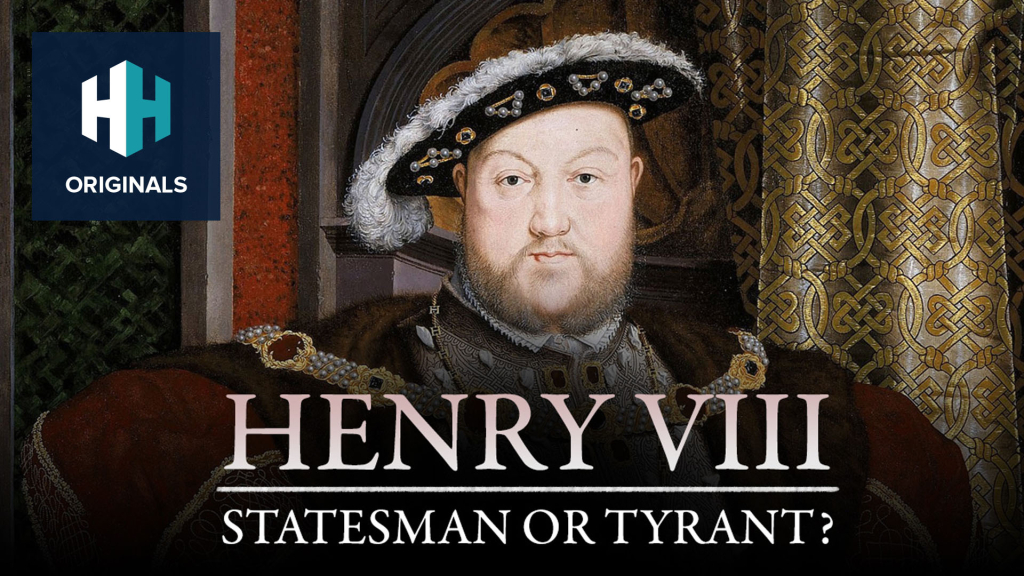
Henry VIII was king of propaganda. Few of us forget the impression made by the man in Hans Holbein’s famous 1537 portrait: chin jutting forward, fists clenched, legs spread wide and a corpulent body bedecked in furs, jewels and glittering gold.
But it’s Henry VIII’s challenging, dictatorial gaze that lingers longest in the mind. This, we believe, is Henry VIII. But history tells a different story.
 Listen Now
Listen NowIn fact, Henry’s lavish artwork, architecture and festivities often belied a precarious reign.
Obsessed with how he would be viewed by posterity, Henry recognised the power of propaganda – and used it to full effect.
Coronation
Along with his queen, Catherine of Aragon, Henry was crowned on Midsummer’s Day – a day when the boundaries between natural and supernatural dissolved, and any beautiful thing was meant to be made possible.
 Watch Now
Watch NowThe streets of London were decorated with tapestries and hung with cloth of gold, symbolising the majesty of the reign to follow.
The Field Of The Cloth Of Gold
In June 1520, Henry VIII and Francis I hosted a kind of medieval Olympics, the Field of the Cloth of Gold, in an attempt to strengthen the bond between the two countries.
The event got its unusual name from the luxurious materials used for the tents and pavilions, while a palace was specifically built for the occasion by 6000 men from England and Flanders. The framework was of timber specially imported from the Netherlands, two enormous fountains were filled with free flowing beer and wine, and the windows were made of real glass.

Even Henry’s armour made a powerful statement. The Tonley armour featured etched decorations including figures of St George, the Virgin and Child, and Tudor Roses – enshrining Henry in his own pantheon.
The reputation of the Field of the Cloth of Gold spread throughout Europe, not simply as a vastly expensive exercise in image building, but as regal glory in action.
Palaces
When Henry seized the wealth that had been amassed by the Catholic Church, he became possibly the richest monarch in English history. He decided to lavish some of this extraordinary wealth on palaces and treasures – the ultimate status symbols.

His most famous residence, Hampton Court Palace, was devoted to pleasure, celebration and ostentatious displays. When it was finished in 1540, it was the most magnificent and sophisticated palace in England. The King rebuilt his own rooms in the palace at least half a dozen times throughout his reign.
The 1537 Portrait
Hans Holbein the Younger’s portrait was painted for one such palace: the Palace of Whitehall, a sprawling labyrinth of courtyards and offices stretching over 23 acres. It was the largest royal residence in Europe.
 Watch Now
Watch NowHolbein painted Henry, along with his current queen, Jane Seymour, and his parents Henry VII and Elizabeth of York, for a mural that was to hang in the privy chamber, the very heart of Whitehall. Various copies were made at the king’s order or for sycophantic courtiers; some remain in important private houses to this day.
The portrait refuted every standard of decorum. The lavishness and boldness was considered vulgar by European aristocracy, where arbiters of Renaissance taste demanded that royals never be depicted full face. Research has shown that Holbein originally painted three-quarters of Henry’s face; the change must have been at Henry’s own request.

The portrait declares that Henry was a warrior king who had vanquished his combatants, a monarch who was more from the realm of legend than reality.
He stands front and centre of his dynastic heritage, proudly proclaiming both his virility and his legacy. But the Latin inscription in the middle of the picture describes the achievements of the first two Tudors and proclaims the son the better man.
 Listen Now
Listen NowIn reality, the portrait was painted in the months following the most disastrous year of Henry’s reign. In the previous autumn, rebellion surged across the northern half of the kingdom. Heavy taxation and forced religious changes had led to dangerous and widespread revolt. Moreover, in 1536 he had been in a bad accident that many had feared would result in his death.
Had Henry died leaving no male heir, he would have plunged England back into the throes of contested leadership. After 27 years on the throne, he had undertaken little of note beyond failed military expeditions that had almost bankrupted the treasury.
But his masterful handling of propaganda ensures that the physical image of Henry that stays with us today is of his decadence – even if he is also rightly remembered for his bloodthirsty cruelty.














